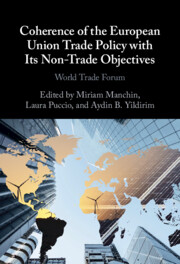Book contents
- Coherence of the European Union Trade Policy with Its Non-Trade Objectives
- Coherence of the European Union Trade Policy with Its Non-Trade Objectives
- Copyright page
- Contents
- Contributors
- Introduction
- 1 European Union Trade Policy and Non-Trade Issues
- 2 The European Union
- 3 Export Credit Agencies
- 4 The Effects of Non-Trade Provisions in Trade Agreements on Bilateral FDI
- 5 How EU Trade and Cooperation Policies Stimulated China to Go Green
- 6 The Role of Domestic Factors in the EU’s Governance of Labour Standards through Trade
- 7 EU Trade Agreements and Non-Trade Policy Objectives
- 8 Trade, the G20 and the EU
- 9 Enhancement of the European Parliament’s Monitoring for Better Coherence between Trade Policy and NTPOs
- Conclusion
- Index
- References
4 - The Effects of Non-Trade Provisions in Trade Agreements on Bilateral FDI
Published online by Cambridge University Press: 19 October 2023
- Coherence of the European Union Trade Policy with Its Non-Trade Objectives
- Coherence of the European Union Trade Policy with Its Non-Trade Objectives
- Copyright page
- Contents
- Contributors
- Introduction
- 1 European Union Trade Policy and Non-Trade Issues
- 2 The European Union
- 3 Export Credit Agencies
- 4 The Effects of Non-Trade Provisions in Trade Agreements on Bilateral FDI
- 5 How EU Trade and Cooperation Policies Stimulated China to Go Green
- 6 The Role of Domestic Factors in the EU’s Governance of Labour Standards through Trade
- 7 EU Trade Agreements and Non-Trade Policy Objectives
- 8 Trade, the G20 and the EU
- 9 Enhancement of the European Parliament’s Monitoring for Better Coherence between Trade Policy and NTPOs
- Conclusion
- Index
- References
Summary
Preferential trade agreements (PTAs) have been estimated to increase bilateral foreign direct investment (FDI) between the signing countries. There is, however, significant heterogeneity between PTAs, and, with increasing frequency, several non-trade issues (NTIs) are also incorporated into PTAs. These include provisions on political and civil rights, economic and social rights, and environmental protection measures. Given the overall intrinsic heterogeneity in PTAs, it is relevant to analyse which of their characteristics are driving the increase in bilateral FDI flows after signing a trade agreement. The chapter uses a structural gravity model of FDI to empirically test the specific relation between non-trade provisions contained in preferential trade agreements with bilateral FDI. It is found that NTI provisions have, if any, a positive relation with bilateral FDI. The civil and political rights (CPR) index has a positive, significant and robust relation with bilateral FDI. However, the other two indicators, economic and social rights (ESR) and environmental protection (EP), usually have positive coefficient signs, but they are not robust to different specifications. The policy implications of these results are that we do not find any negative relation between including more and/or stronger non-trade provision in trade agreements and FDI flows.
Keywords
- Type
- Chapter
- Information
- Coherence of the European Union Trade Policy with Its Non-Trade ObjectivesWorld Trade Forum, pp. 89 - 115Publisher: Cambridge University PressPrint publication year: 2023



